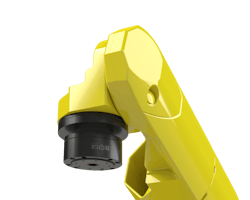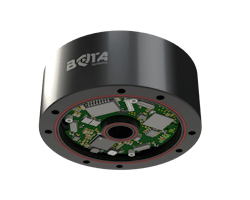Bota Systems’ PixONE Through-hole Sensor is Designed for Robotics
The PixONE through-hole sensor is designed for integration into robotic systems and features high-performance electronics in a compact and lightweight build. Its architecture enables internal cable routing, enhancing the agility and safety of robots by streamlining cable management between the robot’s arm and end-of-arm tooling (EOT).
This design is made to align with the industry trend toward internal cable routing for improved performance. Its hollow shaft design helps maintain smooth internal cable routing to avoid tangles and restrictions. The sensor’s two-piece construction simplifies assembly and reduces weight by 30% compared to similar sensors, which is crucial for the performance of fast-moving robots.
Offered in a range of models, this sensor features an integrated inertial measurement unit (IMU) and has an IP67 waterproof rating for durability across different operational environments. Its external diameter starts at 2.36 in. (60 mm) with a 0.59-in. (15 mm) through-hole diameter.
READ MORE: Automate 2024: Bota’s Sensing Technologies for Industrial Applications
Key features of PixONE include:
- Designed for automation in industrial robotics and advanced robotics applications
- Internal cable routing for robot agility and safety
- High torque-to-force ratio for EOT design flexibility
- Software integration compatibility with TwinCAT, LabVIEW, ROS and MATLAB.
PixONE supports payloads up to 250 kg and offers a uniform interface for seamless integration across all models. The sensor’s higher torque-to-force ratio provides integrators with design flexibility, especially for EOT with larger tools.
Because it uses EtherCAT technology for high speed data communication and support for Power over Ethernet (POE), PixONE simplifies electrical installations.
READ MORE: eBook: Automate 2024 Snapshot: Robotics, Automation, AI and More
About the Author
Sharon Spielman
Technical Editor, Machine Design
As Machine Design’s technical editor, Sharon Spielman produces content for the brand’s focus audience—design and multidisciplinary engineers. Her beat includes 3D printing/CAD; mechanical and motion systems, with an emphasis on pneumatics and linear motion; automation; robotics; and CNC machining.
Spielman has more than three decades of experience as a writer and editor for a range of B2B brands, including those that cover machine design; electrical design and manufacturing; interconnection technology; food and beverage manufacturing; process heating and cooling; finishing; and package converting.
Email: [email protected]
LinkedIn: @sharonspielman
Facebook: Machine Design
YouTube: @MachineDesign-EBM


